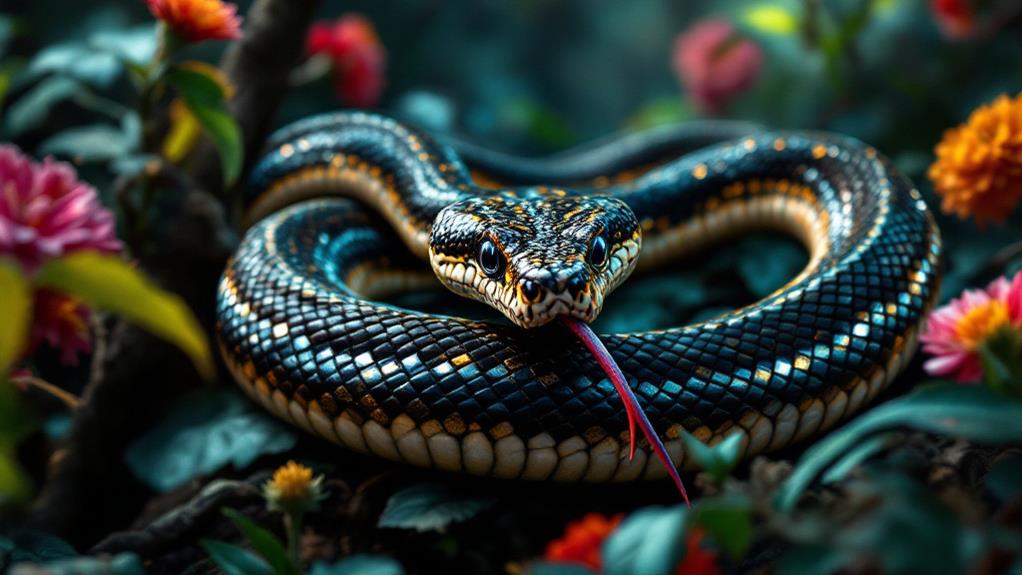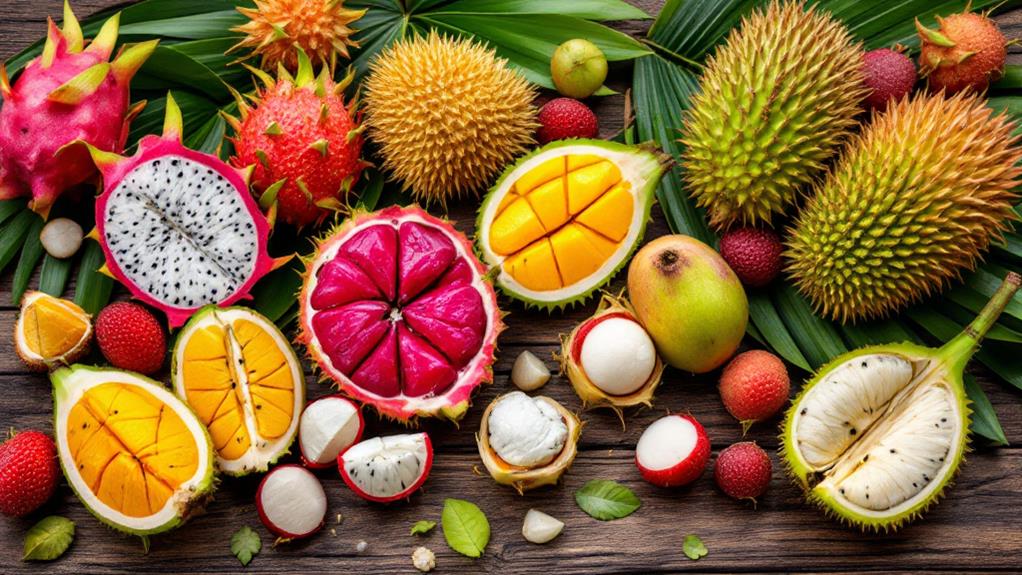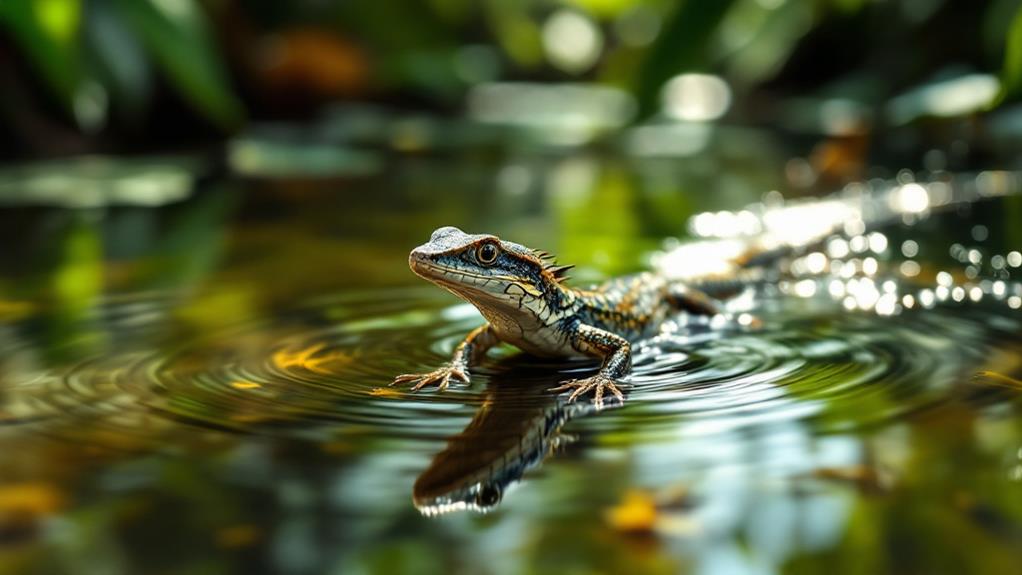Weirdest Trees in the World: Nature’s Most Unusual Arboreal Wonders
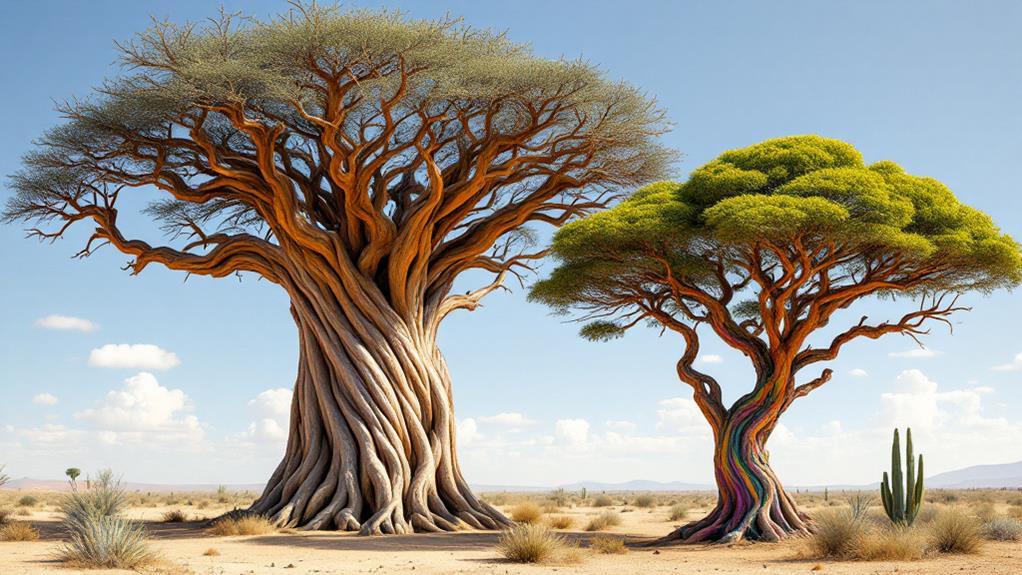
Nature's weirdest trees will astound you with their bizarre shapes and incredible adaptations. You'll find the Dragon Blood Tree's umbrella-like canopy, the massive water-storing Baobab, and the vibrant, colorful Rainbow Eucalyptus. Don't miss the bottle-shaped Australian icon or the parasitic Strangler Fig. The ancient Wollemi Pine, once thought extinct, still thrives today. Marvel at the candelabra-like branches of southern Africa's succulent tree and Socotra's unique Cucumber Tree. You might even spot the Walking Palm, which can slowly shift its position over time. These arboreal wonders are just the tip of the forest canopy when it comes to nature's most unusual trees.
The Dragon Blood Tree
Otherworldly in appearance, the Dragon Blood Tree stands as a bizarre botanical wonder. You'll find this peculiar species on the Socotra archipelago off the coast of Yemen, where it's adapted to the harsh, arid environment. Its most striking feature is its unique branching pattern, resembling an upturned umbrella or a giant mushroom.
The tree's name comes from its dark red resin, which oozes when the bark is cut. This "dragon's blood" has been prized for centuries for its medicinal uses and as a dye. You might be surprised to learn that it's still used today in varnishes, pottery glazes, and even lipstick.
Despite its alien appearance, the Dragon Blood Tree plays an integral role in Socotra's ecosystem. Its dense canopy provides shade and shelter for various plants and animals. Unfortunately, climate change and overgrazing threaten its survival. Conservation efforts are underway to protect this living fossil, which has remained largely unchanged for millions of years. If you ever visit Socotra, you'll witness a terrain that seems more like a distant planet than Earth, thanks to these extraordinary trees.
Baobab: Africa's Upside-Down Tree
Few trees mesmerize the imagination quite like the baobab, often called Africa's upside-down tree. You'll find these giants scattered across the continent's savanna regions, where their distinctive silhouettes dominate the scenery. The baobab's unique growth pattern gives it an almost cartoonish appearance, with a massive trunk supporting relatively small, sparse branches that resemble roots reaching for the sky.
These extraordinary trees have evolved drought-resistant adaptations that allow them to thrive in harsh environments. Their spongy wood can store thousands of liters of water, enabling them to survive long dry spells. Baobabs also shed their leaves during drought to conserve moisture.
They can live for over 2,000 years, making them among the oldest living organisms on Earth. Their trunks can reach up to 36 meters in circumference. Baobab fruit is highly nutritious and often called "superfood".
You'll be amazed by the baobab's versatility. Local communities use every part of the tree, from its bark for rope and cloth to its fruit for food and medicine. These iconic trees truly embody nature's resilience and ingenuity.
Rainbow Eucalyptus
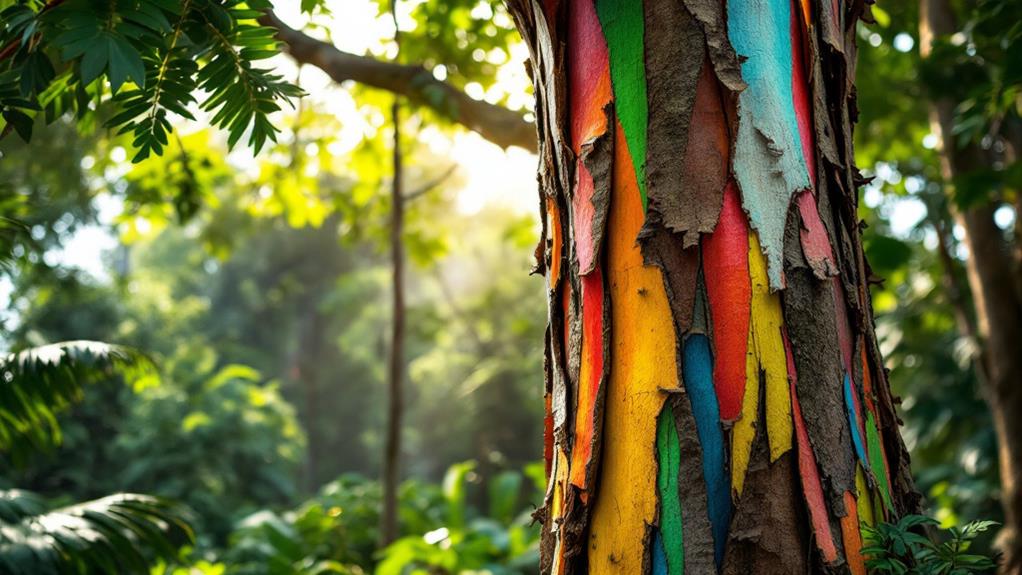
Nature's artistry reaches its peak with the Rainbow Eucalyptus, a tree that seems straight out of a Dr. Seuss book. You'll find these living works of art primarily in tropical and subtropical forests, where they captivate observers with their vibrant, ever-changing appearance.
The Rainbow Eucalyptus's most striking feature is its colorful shedding bark. As the outer layers peel away, they reveal a kaleidoscope of hues beneath. You'll see streaks of green, blue, purple, orange, and red adorning the trunk, creating a mesmerizing patchwork effect. This continuous shedding process guarantees that the tree's appearance is always evolving, providing a fresh spectacle with each visit.
Beyond its technicolor trunk, you'll notice the tree's unusual branch patterns. The Rainbow Eucalyptus grows tall and straight, with a sparse canopy that allows sunlight to filter through. Its branches often twist and turn in unexpected ways, adding to the tree's whimsical charm. As you admire this natural wonder, you'll understand why it's considered one of the world's weirdest and most beautiful trees.
The Bottle Tree
Moving from rainbow hues to bizarre shapes, we encounter the Bottle Tree, a peculiar species native to Australia. You'll be engrossed by its interesting shape, resembling a giant bottle or flask with a bulbous trunk and skinny branches. This unique adaptation allows the tree to store water in its swollen trunk, helping it survive in arid conditions.
The Bottle Tree, scientifically known as Brachychiton rupestris, has evolved to thrive in Australia's harsh climate. You'll find these trees scattered across Queensland and New South Wales, standing out with their distinctive silhouettes against the terrain.
It can grow up to 20 meters tall and 3 meters in diameter. The trunk's water storage capacity can reach up to 1,000 liters. Indigenous Australians have traditionally used the tree for food, fiber, and medicine.
You'll appreciate the Bottle Tree's resilience and ingenuity in adapting to its environment. Its ability to store water makes it a crucial resource for local wildlife during dry seasons, showcasing nature's impressive problem-solving capabilities.
Strangler Fig
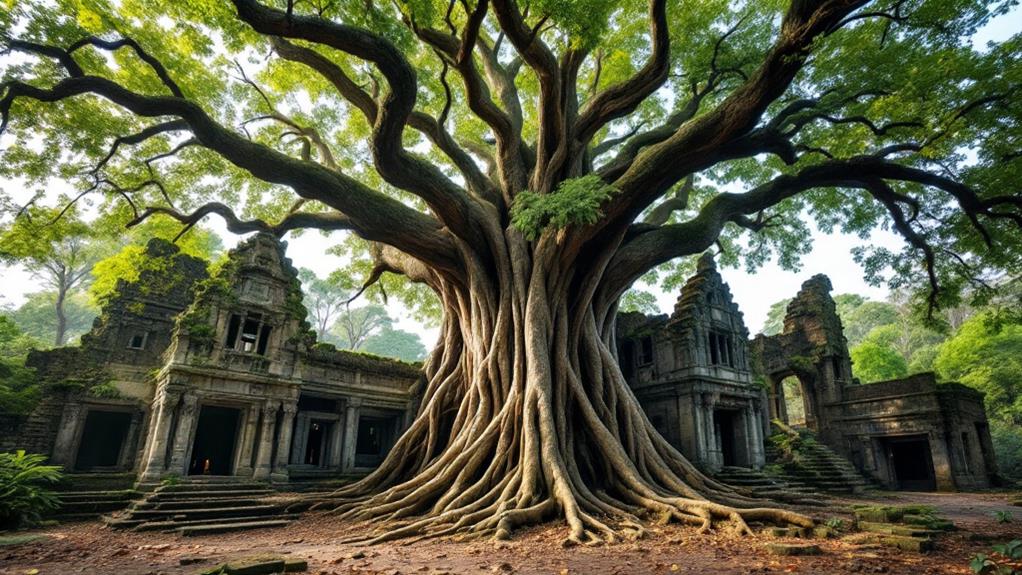
Deception lurks in the world of trees, and the Strangler Fig embodies this perfectly. You might mistake it for a harmless vine at first, but don't be fooled. This cunning plant begins its life as an epiphyte, growing on the branches of other trees. As it matures, it develops an aerial root system that reaches down to the ground, encasing its host tree.
The Strangler Fig's name isn't just for show. It gradually tightens its grip, competing for nutrients and sunlight. Over time, it can completely envelop its host, creating a hollow tree-like structure. Despite this seemingly parasitic behavior, the relationship between the Strangler Fig and its host is often symbiotic. The fig provides support and protection for various wildlife, while the host tree gains additional stability.
You'll find these fascinating trees in tropical and subtropical regions worldwide. Their unique growth pattern results in surreal, lattice-like structures that seem to defy gravity. While the Strangler Fig's methods may seem harsh, it is a shining example of nature's ingenuity and the complex relationships that exist in forest ecosystems.
Wollemi Pine: Living Fossil
A true botanical marvel, the Wollemi Pine stands as a living record of Earth's ancient history. You'll be amazed to learn that this "living fossil" was thought to be absent for millions of years until its uncovering in 1994 in Australia's Blue Mountains. With its ancient lineage dating back to the time of dinosaurs, the Wollemi Pine offers a glimpse into prehistoric terrains.
This rare conifer boasts unique characteristics that set it apart:
- Distinctive bubbly bark resembling chocolate crackles
- Unusual branching pattern with multiple trunks
- Ability to sprout new shoots from its base, even when damaged
The Wollemi Pine's survival through millennia showcases its exceptional climate change resilience. It's adapted to various environmental conditions, from scorching heat to freezing temperatures. Today, conservation efforts are underway to protect this critically endangered species. You can even grow your own Wollemi Pine, as seedlings are now available for purchase. By cultivating these living fossils, you're not just adding a unique tree to your garden; you're participating in preserving a piece of Earth's natural heritage.
Candelabra Tree
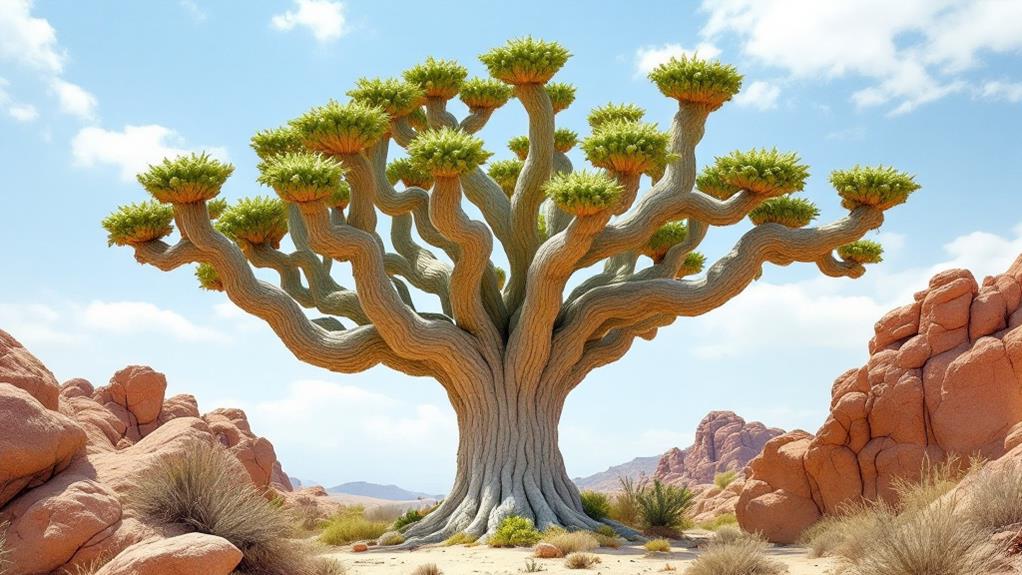
The Candelabra Tree, scientifically known as Euphorbia ingens, stands out as one of Africa's most peculiar succulents. You'll find this extraordinary tree in the savannas and rocky areas of southern Africa, where it can grow up to 40 feet tall. Its name comes from its unique branching structure, which resembles a candelabra or chandelier.
What makes this tree truly weird is its appearance. Instead of leaves, you'll see dense foliage patterns formed by clusters of small, green, fleshy branches. These branches grow vertically from the main trunk, creating a distinctive silhouette against the African sky. The tree's thick, succulent stems store water, allowing it to thrive in arid environments.
Be cautious if you encounter a Candelabra Tree in the wild. It produces a toxic, milky latex that can cause skin irritation and blindness if it gets in your eyes. Despite its hazardous nature, the tree plays a pivotal role in its ecosystem, providing shelter and food for various wildlife species. You'll be amazed by how this weird tree has adapted to its harsh environment, showcasing nature's incredible diversity.
Socotra's Cucumber Tree
On the remote island of Socotra, you'll encounter one of the world's strangest trees: the Cucumber Tree (Dendrosicyos socotranus). This peculiar plant is found nowhere else on Earth and has adapted to the island's harsh, arid climate in extraordinary ways.
The Cucumber Tree's most striking feature is its bulbous, bottle-shaped trunk. This unique adaptation allows it to store water, helping the tree survive long periods of drought. You'll notice that the tree's bark is smooth and pale, reflecting sunlight to prevent water loss.
The Cucumber Tree's seasonal leaves appear during the rainy season, providing shade and helping the tree photosynthesize. When conditions become dry, it sheds its foliage to conserve water. The tree produces unusual fruit that resembles small, elongated cucumbers, giving it its common name. These fruits are inedible to humans but provide a crucial food source for the island's wildlife.
The Walking Palm
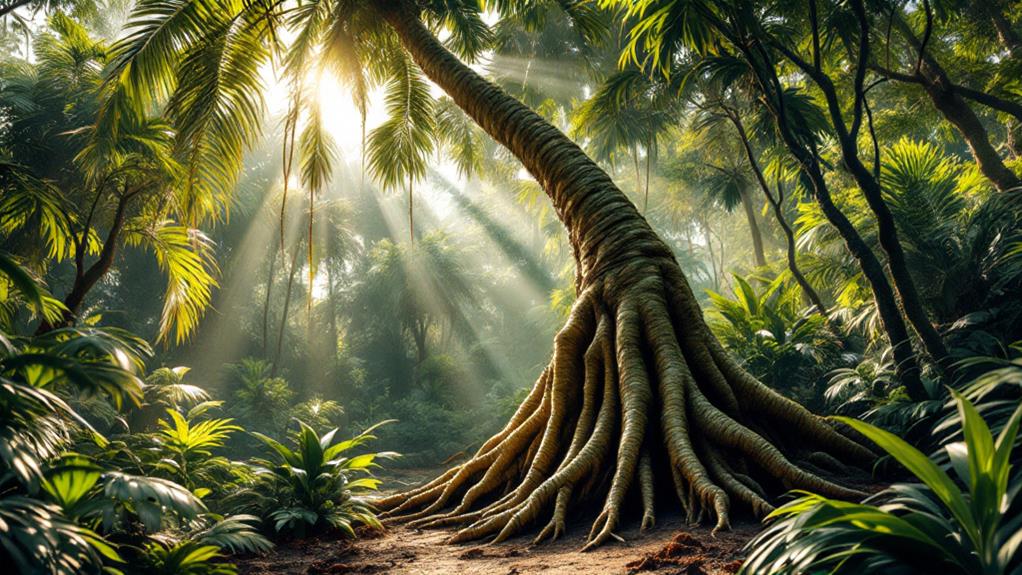
Moving from Socotra's unique flora, we find another peculiar tree in the Amazon rainforest. The Walking Palm, or Socratea exorrhiza, is a tree that's captured the imagination of locals and scientists alike. You might wonder how a tree can "walk," and while it doesn't actually uproot itself and stroll through the forest, it has a fascinating method of movement.
This palm grows new roots from its trunk, allowing it to slowly shift position over time. As older roots die and newer ones grow, the tree can potentially move up to 20 centimeters per year. This unique adaptation mechanism helps the Walking Palm find better light sources and more stable ground.
The tree's interesting cultural significance is evident in local legends. Some indigenous groups believe these palms can walk away from danger or towards water sources. While scientists debate the extent of the tree's movement, its stilt-like roots undoubtedly make it stand out. You'll find the Walking Palm's distinctive appearance and supposed mobility make it one of the most intriguing trees in the Amazon, challenging our perceptions of plant life.
